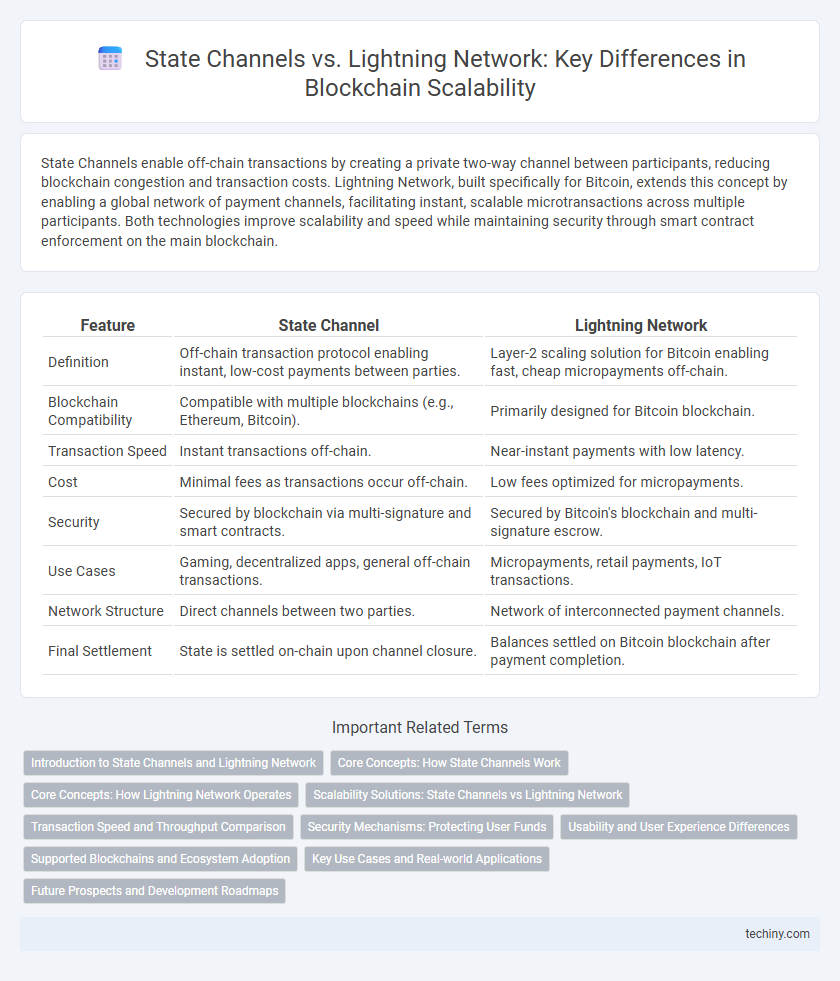State Channels enable off-chain transactions by creating a private two-way channel between participants, reducing blockchain congestion and transaction costs. Lightning Network, built specifically for Bitcoin, extends this concept by enabling a global network of payment channels, facilitating instant, scalable microtransactions across multiple participants. Both technologies improve scalability and speed while maintaining security through smart contract enforcement on the main blockchain.
Table of Comparison
| Feature | State Channel | Lightning Network |
|---|---|---|
| Definition | Off-chain transaction protocol enabling instant, low-cost payments between parties. | Layer-2 scaling solution for Bitcoin enabling fast, cheap micropayments off-chain. |
| Blockchain Compatibility | Compatible with multiple blockchains (e.g., Ethereum, Bitcoin). | Primarily designed for Bitcoin blockchain. |
| Transaction Speed | Instant transactions off-chain. | Near-instant payments with low latency. |
| Cost | Minimal fees as transactions occur off-chain. | Low fees optimized for micropayments. |
| Security | Secured by blockchain via multi-signature and smart contracts. | Secured by Bitcoin's blockchain and multi-signature escrow. |
| Use Cases | Gaming, decentralized apps, general off-chain transactions. | Micropayments, retail payments, IoT transactions. |
| Network Structure | Direct channels between two parties. | Network of interconnected payment channels. |
| Final Settlement | State is settled on-chain upon channel closure. | Balances settled on Bitcoin blockchain after payment completion. |
Introduction to State Channels and Lightning Network
State channels enable off-chain transactions between participants, increasing scalability and reducing blockchain congestion by settling final states on-chain only. The Lightning Network is a specific implementation of state channels designed for Bitcoin, facilitating instant, low-fee micropayments through a network of bidirectional payment channels. Both technologies enhance transaction speed and cost-efficiency while preserving blockchain security by minimizing on-chain interactions.
Core Concepts: How State Channels Work
State Channels enable off-chain transactions by creating a private, two-way communication channel between participants, allowing multiple exchanges without recording each on the blockchain. Participants exchange signed transaction states that update balances securely, only submitting the final state to the blockchain for settlement, minimizing on-chain fees and latency. This mechanism enhances scalability and efficiency by reducing blockchain congestion and enabling instant payment confirmations.
Core Concepts: How Lightning Network Operates
The Lightning Network operates as a layer-2 payment protocol built on top of blockchain networks like Bitcoin, enabling fast, low-cost transactions through off-chain payment channels. By creating bidirectional channels between participants, it allows multiple microtransactions without broadcasting each to the main blockchain, improving scalability and reducing congestion. State channels underpin this mechanism by securely locking funds on-chain and updating balances off-chain until the final state is settled on the blockchain.
Scalability Solutions: State Channels vs Lightning Network
State Channels and the Lightning Network are off-chain scalability solutions designed to enable faster and cheaper transactions on blockchain networks. State Channels facilitate multiple blockchain interactions by locking funds in a multi-signature contract and settling the net result on-chain, significantly reducing on-chain transaction load. The Lightning Network, primarily used on Bitcoin, extends State Channel principles by enabling a network of interconnected payment channels, allowing instant microtransactions with minimal fees and enhanced scalability.
Transaction Speed and Throughput Comparison
State channels enable off-chain transactions to achieve near-instant finality and high throughput by conducting multiple transactions off the main blockchain before settling on-chain, significantly reducing latency. Lightning Network, a specific implementation of state channels on Bitcoin, optimizes microtransactions with similar high-speed, low-fee transaction capabilities but is specialized for Bitcoin's protocol constraints. Both solutions enhance transaction speed and scalability well beyond on-chain limits, but state channels can support a broader range of blockchain platforms while Lightning Network is tailored primarily for fast Bitcoin payments.
Security Mechanisms: Protecting User Funds
State Channels secure user funds by locking assets on the blockchain through multi-signature wallets, enabling off-chain transactions verified by cryptographic proofs without exposing funds to third-party risks. The Lightning Network enhances security by implementing hashed timelock contracts (HTLCs), which ensure conditional payments that can be reclaimed if counterparty misbehavior occurs. Both technologies utilize dispute resolution mechanisms on-chain to protect users from fraudulent actions, prioritizing fund safety during off-chain transaction settlement.
Usability and User Experience Differences
State Channels enable off-chain transactions with instant finality, minimizing on-chain fees and offering smooth user experiences for repetitive interactions, ideal for gaming or micro-payments. Lightning Network, designed primarily for Bitcoin, facilitates instant, low-cost payments across a global network but requires users to manage payment channels and liquidity, which can complicate usability for non-technical users. While State Channels prioritize seamless, application-specific interactions, Lightning Network emphasizes scalability and interoperability, impacting user experience based on the complexity of channel management and network routing.
Supported Blockchains and Ecosystem Adoption
State channels support a wide range of blockchains, including Ethereum, Bitcoin, and various layer-2 protocols, offering versatile use cases in decentralized finance and gaming. The Lightning Network is specifically designed for Bitcoin, enhancing its scalability with rapid, low-cost transactions while benefiting from Bitcoin's robust security and large user base. Ecosystem adoption varies as the Lightning Network boasts significant integration across wallets and exchanges, whereas state channels experience growing but more niche deployment within specific blockchain communities.
Key Use Cases and Real-world Applications
State Channels enable fast, low-cost off-chain transactions ideal for micro-payments, gaming, and decentralized exchanges by reducing on-chain congestion. The Lightning Network, specifically designed for Bitcoin, facilitates instant, scalable payments with minimal fees, making it perfect for everyday retail purchases and cross-border remittances. Both solutions enhance blockchain scalability but differ in protocol design and asset compatibility, influencing their deployment across various financial and operational use cases.
Future Prospects and Development Roadmaps
State Channel technology and the Lightning Network are pivotal in scaling blockchain payment solutions, with ongoing enhancements aimed at improving transaction speed and reducing fees. Future development roadmaps emphasize interoperability, enhanced security protocols, and broader adoption across multiple blockchain platforms. Continued research and implementation are expected to drive mainstream integration, enabling seamless microtransactions and off-chain asset management.
State Channel vs Lightning Network Infographic

 techiny.com
techiny.com